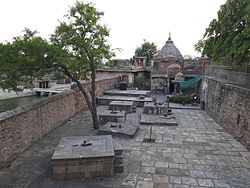Kanswa Kansua | |
|---|---|
City | |
 Shiva temple at Kanswa | |
 | |
| Country | |
| State | Rajasthan |
| Languages | |
| • Official | Hindi |
| Time zone | UTC+5:30 (IST) |
| ISO 3166 code | RJ-IN |
Kanswa, also spelled Kansua, is a village in the Kota district of Rajasthan, India. It is of archaeological importance. [1] It is the site where James Tod found an inscription in 1820 AD that reveals the rule of the Jat king Maharaja Shalinder in Kota region in 5th century AD. [2]
The Dabok stone inscription, dating back to Gupta Samvat 407 (circa 725 AD), records events during the reign of Dhavalappadeva. This ruler is likely identified with Dhavala, a prince from the Maurya dynasty mentioned in the Kanswa inscription of Vikrama Samvat 795 (738 AD). [3]